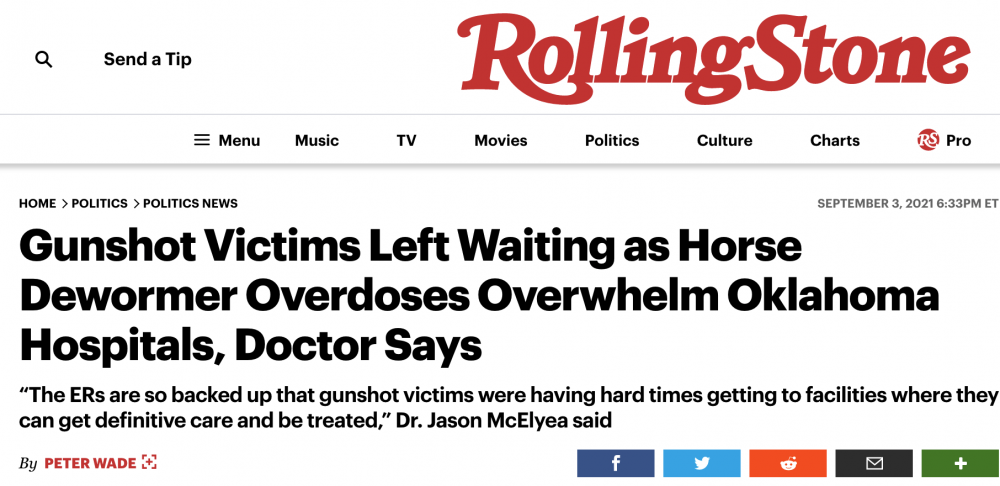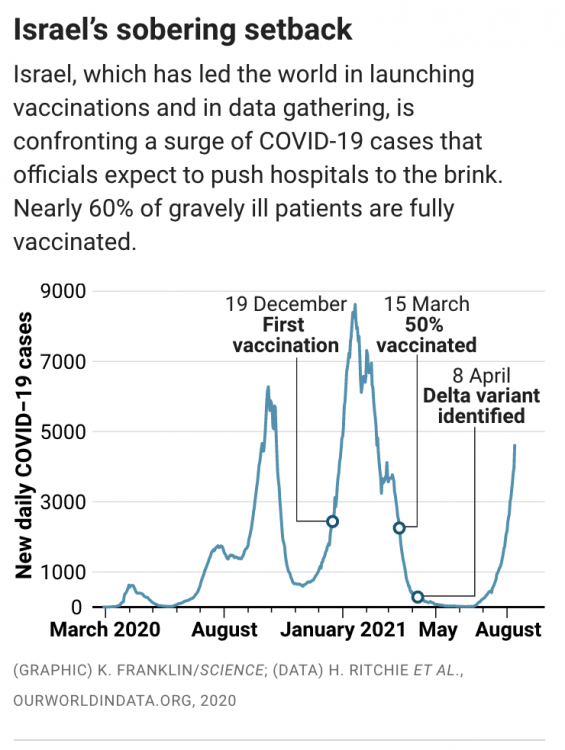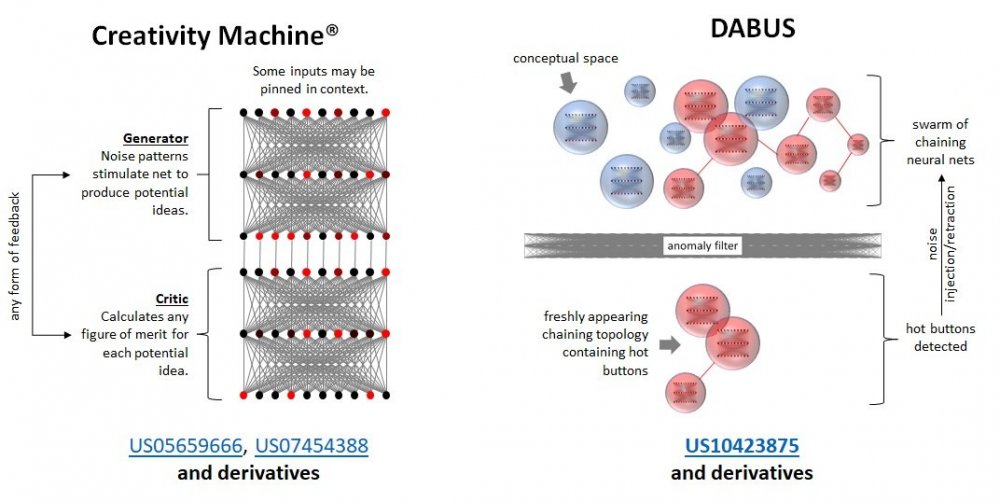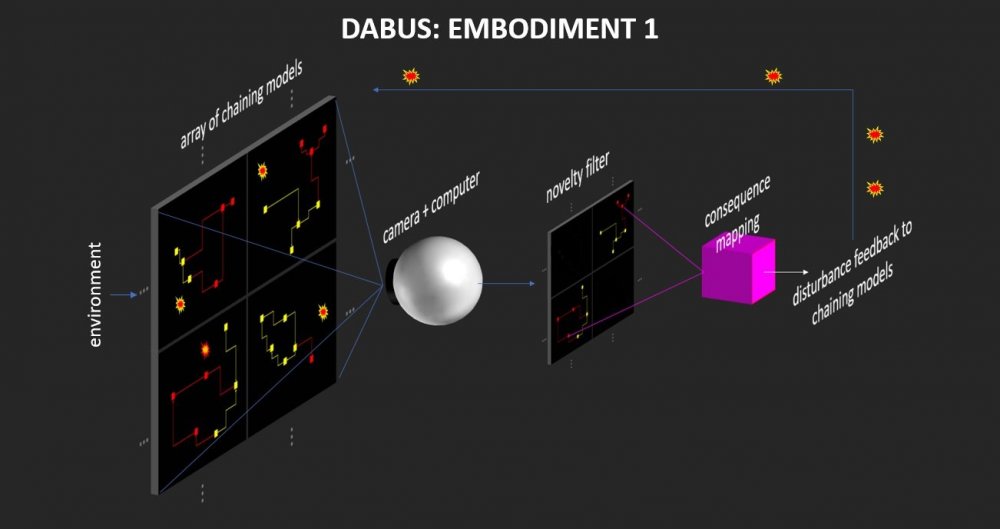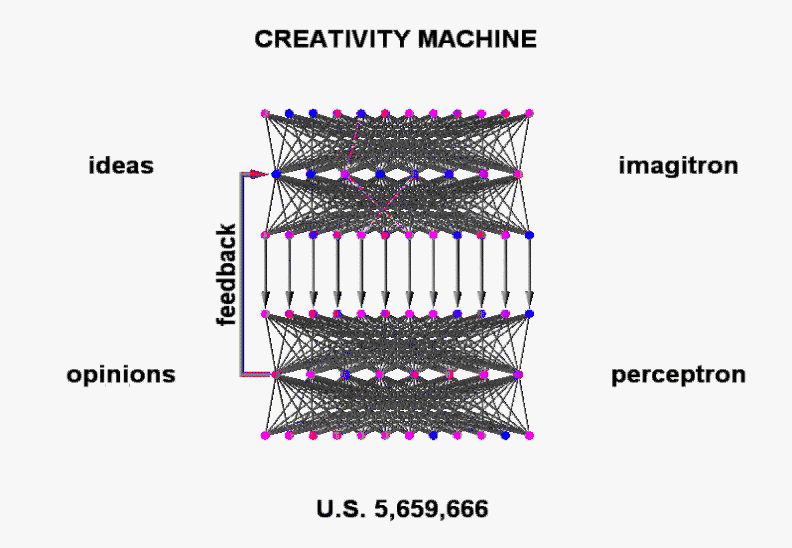Everything posted by Alex_Krycek
-
COVID-19 antivirals and vaccines (Megathread)
Just pointing out that there's more noise than signal these days, and supposedly reputable outlets aren't immune from the fray. It's easy to get caught up in the tribalism and name calling. If they're presented with information that refutes the veracity of the story, they should retract the story, not leave it up as a clickbait headline. You can't have an entire article portraying the situation in a particular light, based on facts that are then completely undermined with an update appended at the end of the article. Disingenuous. I wrote to The Guardian this morning to request a retraction. As a paid subscriber I expect better of them. I'm interested in any information about the efficacy of Ivermectin, for treatment of prophylaxis. I doubt it, but not many people have access to remdesivir, or the other treatments currently available or in the pipeline. If people who need a treatment option now can use Ivermectin safely and effectively, why not? All reasonable options should be on the table.
-
COVID-19 antivirals and vaccines (Megathread)
Here's an example of some recent misinformation about Ivermectin in the media. Rolling Stone, CNN, The Guardian, Fox News, and several other media outlets ran a story about an Oklahoma ER at the NHS Sequoyah hospital. The source was Dr. Jason McElyea, supposedly an ER doctor at the facility. Mr. McElyea's statements and portrayal of the situation were refuted by the hospital on their website. Here's the headlines that The Guardian and Rolling Stone went with: It turns out that Dr. Jason McElyea hasn't worked at NHS Sequoyah in months, and the hospital issued a formal correction on their website, to counter the false headlines: Sources: https://nhssequoyah.com/ https://www.theguardian.com/world/2021/sep/04/oklahoma-doctor-ivermectin-covid-coronavirus https://www.rollingstone.com/politics/politics-news/gunshot-victims-horse-dewormer-ivermectin-oklahoma-hospitals-covid-1220608/
-
Comparing Corona Virus Success Stories with Abysmal Failures
Interesting article about Covid progress in Australia. They're using a new drug called Sotrovimab, which is a type of monoclonal antibody treatment. “Sotrovimab is an antibody treatment, and one that’s been shown in good clinical trials to have a dramatic impact in reducing people’s probability of progressing to severe disease,” Griffin said. “If there’s someone who’s high risk at developing severe symptoms, it can be given to them. It does need to be given early, before people are very unwell, but in those people it stops very significant progression through to severe disease.” https://www.theguardian.com/world/2021/sep/04/covid-treatment-improving-as-doctors-learn-to-fight-the-disease-and-access-new-drugs https://en.wikipedia.org/wiki/Sotrovimab
-
COVID Mandatory vaccinations
This issue will go to the Supreme Court in the US, in my view. Too many legal principles at stake that need to be sorted out.
-
COVID-19 antivirals and vaccines (Megathread)
The media in the US is corporate in nature, driven by profit and special interests. Would anyone have a problem criticizing the media's deceptiveness regarding the wars in Afghanistan or Iraq? Probably not. We all recognize the influence that the military industrial complex and defense contractors have on Washington legislators and the corporate media. It would no doubt be much more acceptable to you to criticize the media if we were discussing those topics, but if one implies that there is some selective messaging going on with respect to Covid, then suddenly criticizing the media is off limits. Why can we criticize the media in some areas but not others? I find this inconsistent. The Pharma lobby is one of the most powerful in the US. Of course it is plausible that the corporate media would engage in some selective messaging to turn people away from possible cheap alternatives to Covid, as they turned people towards the idea of WMDs in Iraq, or away from the Public Option (it would run insurance companies out of business, right?), and as the media seeks to shape the narrative around a myriad of other issues (universal healthcare, UBI, certain political ideas that fall outside of the status quo, etc). It's "manufactured consent", as Noam Chomsky puts it. The narrow dialogue and fixation on classifying Ivermectin as only a horse dewormer is reflective of this. The corporate media rarely mentions that Ivermectin is a safe drug that has been used worldwide for decades, nor will they mention the study that I had to proactively search out to begin to understand the full picture. Instead, the media hypes up the cases of people who misuse the drug, which is a small minority. Omit any news about Ivermectin to the contrary, and voila - manufactured consent. It's selective and self serving messaging, with an obvious objective of tarring as fringe elements those who might want to discuss Ivermectin. This in turn gives license to those who blithely follow this narrative to ridicule those who they perceive as ignorant and uninformed. In the context of what they have been led to believe, this self righteous condescension is logical, but they're missing the bigger picture. These are the sections from the study that I found most relevant: 1. Ivermectin is a well-known medicine that is approved as an antiparasitic by the World Health Organization and the US Food and Drug Administration. It is widely used in low- and middle-income countries (LMICs) to treat worm infections. 2,3 Also used for the treatment of scabies and lice, it is one of the World Health Organization’s Essential Medicines.4 With total doses of ivermectin distributed apparently equaling one-third of the present world population,5 ivermectin at the usual doses (0.2–0.4 mg/kg) is considered extremely safe for use in humans. 6,7 In addition to its antiparasitic activity, it has been noted to have antiviral and anti-inflammatory properties, leading to an increasing list of therapeutic indications.8 2. A review by the Front Line COVID-19 Critical Care Alliance summarized findings from 27 studies on the effects of ivermectin for the prevention and treatment of COVID-19 infection, concluding that ivermectin “demonstrates a strong signal of therapeutic efficacy” against COVID-19. 9 Another recent review found that ivermectin reduced deaths by 75%. 10 3. Ivermectin has exhibited antiviral activity against a wide range of RNA and some DNA viruses, for example, Zika, dengue, yellow fever, and others. 13 Caly et al 14 demonstrated specific action against SARSCoV-2 in vitro with a suggested host-directed mechanism of action being the blocking of the nuclear import of viral proteins 14,15 that suppress normal immune responses. 4. Developing new medications can take years; therefore, identifying existing drugs that can be repurposed against COVID-19 that already have an established safety profile through decades of use could play a critical role in suppressing or even ending the SARS-CoV2 pandemic. Using repurposed medications may be especially important because it could take months, possibly years, for much of the world’s population to get vaccinated, particularly among LMIC populations. 5. All-cause mortality: Meta-analysis of 15 trials, assessing 2438 participants, found that ivermectin reduced the risk of death by an average of 62% (95% CI 27%–81%) compared with no ivermectin treatment [average RR (aRR) 0.38, 95% 0.19 to 0.73; I 2 5 49%]; risk of death 2.3% versus 7.8% among hospitalized patients in this analysis, respectively (SoF Table 2 and Figure 3). 6. The effect on reducing deaths was consistent across mild to moderate and severe disease subgroups. 7. The cumulative z-curve in Figure 8 crossed the trial sequential monitoring boundaries after reaching the required IS, implying that there is firm evidence for a beneficial effect of ivermectin use over no ivermectin use in mainly hospitalized participants with mild to moderate COVID-19 infection. 8. The findings indicate with moderate certainty that ivermectin treatment in COVID-19 provides a significant survival benefit. 9. In addition to the evidence from systematic reviews, the findings of several controlled observational studies are consistent with existing evidence and suggest improved outcomes with ivermectin treatment.55,57,59 Similarly, with respect to ivermectin prophylaxis of frontline workers and those at risk, controlled observational studies from Bangladesh and Argentina (the latter which involved 1195 health care workers) have shown apparent reductions in COVID-19 transmission with ivermectin prophylaxis, including in some reports total protection (zero infections) where infection rates in the control group exceeded 50%. 122, 10. There is also evidence emerging from countries where ivermectin has been implemented. For example, Peru had a very high death toll from COVID-19 early on in the pandemic. 128 Based on observational evidence, the Peruvian government approved ivermectin for use against COVID-19 in May 2020. 128 After implementation, death rates in 8 states were reduced between 64% and 91% over a two-month period. 128 Another analysis of Peruvian data from 24 states with early ivermectin deployment has reported a drop in excess deaths of 59% at 30+ days and of 75% at 45+ days. 129 11. Certain South American countries, Indian states, and, more recently, Slovakia and other countries in Europe have implemented its use for COVID-19. 129,131,132,133,134 12. Given the evidence of efficacy, safety, low cost, and current death rates, ivermectin is likely to have an impact on health and economic outcomes of the pandemic across many countries. Ivermectin is not a new and experimental drug with an unknown safety profile. It is a WHO “Essential Medicine” already used in several different indications, in colossal cumulative volumes. Corticosteroids have become an accepted standard of care in COVID-19, based on a single RCT of dexamethasone. 1 If a single RCT is sufficient for the adoption of dexamethasone, then a fortiori the evidence of 2 dozen RCTs supports the adoption of ivermectin. 13. Ivermectin is likely to be an equitable, acceptable, and feasible global intervention against COVID-19. Health professionals should strongly consider its use, in both treatment and prophylaxis.
-
COVID-19 antivirals and vaccines (Megathread)
Somewhat of an odd analogy, but anyway. Are you calling these authors "uninformed uneducated cranks? Andrew Bryant, MSc,1,* Theresa A. Lawrie, MBBCh, PhD,2 Therese Dowswell, PhD,2 Edmund J. Fordham, PhD,2 Scott Mitchell, MBChB, MRCS,3 Sarah R. Hill, PhD,1 and Tony C. Tham, MD, FRCP4 Should their research and subsequent conclusions not be considered? Again, this discussion is about Ivermectin and research pertaining to it - not us getting emotional and calling each other names.
-
COVID-19 antivirals and vaccines (Megathread)
Some interesting research reported on the NIH website: https://www.ncbi.nlm.nih.gov/pmc/articles/PMC8248252/ Conclusions: Moderate-certainty evidence finds that large reductions in COVID-19 deaths are possible using ivermectin. Using ivermectin early in the clinical course may reduce numbers progressing to severe disease. The apparent safety and low cost suggest that ivermectin is likely to have a significant impact on the SARS-CoV-2 pandemic globally. Source: https://www.ncbi.nlm.nih.gov/pmc/articles/PMC8248252/
-
COVID-19 antivirals and vaccines (Megathread)
FYI - This isn't about you. This thread is about debating the efficacy of Ivermectin.
-
COVID-19 antivirals and vaccines (Megathread)
Do you have links to those studies? Probably a small minority. But as usual, the outliers seem to get all the attention in campaign to dismiss the entire group. Post links to those studies please. Which is why more studies should be conducted. Or it can be used as an alternative treatment for breakthrough infections, until other treatments that are in the pipeline make it to market. I think its fully justifiable for a member of the public who was repeatedly told that vaccines will protect them from Covid and then becomes infected again to consider all possible options. I disagree. There's a lot we still don't know about how to treat Covid. Treatment and prevention are both crucial. Yes, take the vaccine if you have access to it: 100%. However, many do not have access and need something that works in the meantime. In the near future, there may be a vaccine that offers no immunity from a new variant. That is an entirely plausible scenario based on recent events. So the vaccine may not end up being a panacea; all options should be considered. I don't think it's that esoteric. I see it more as group think on both sides. The entire discussion is extremely emotionally charged and polarized, and there isn't much room for nuanced debate. I'm not interested in your emotional outbursts, or being told to "shut up". If you have something to contribute to the debate, do so.
-
COVID-19 antivirals and vaccines (Megathread)
This type of response is exactly what I'm talking about. Thanks for proving my point. https://www.science.org/news/2021/08/grim-warning-israel-vaccination-blunts-does-not-defeat-delta
-
COVID-19 antivirals and vaccines (Megathread)
I disagree. There's several factors at play that supersede the statements you made: First, in developed countries, there is widespread derision and condescension of those who use Ivermectin, or any other alternative treatment, such that it precludes actual objective analysis or sober discussion about the possible merits of alternative treatments. It's become en vogue in the West of late to ridicule and pillory those who choose any option other than vaccination, a kind of self righteousness that isn't productive to exploring different treatment options. The knee jerk response is to refer to drugs like Ivermectin, which have been used safely for decades, as "snake oil", or classify it solely as a dewormer. This type of inaccurate framing is unhelpful. Part of this stems from political partisan nonsense. Every article on Ivermectin seems to immediately mention Tucker Carlson, Sean Hannity, and Laura Ingraham, as if these individuals are at all relevant to the conversation. Let's dispense with the partisan nonsense and focus on the actual drug. Ivermectin has been used safely to treat various human parasitic infestations for decades. It is extremely cheap to produce, making it ideal for lower income countries with fledgling healthcare systems. So far many front line physicians in the US and worldwide have prescribed it and reported positive results. Ivermectin is a medication that is used to treat parasite infestations. In humans, this includes head lice, scabies, river blindness (onchocerciasis), strongyloidiasis, trichuriasis, ascariasis, and lymphatic filariasis. Source: https://en.wikipedia.org/wiki/Ivermectin Second, the reason the current dialogue is counterproductive is because it ignores what actual data there may be. Millions of people around the world, especially in South America and India have been, and are already, taking Ivermectin. What is their experience? How effective has treatment been for them? We don't know because it's not considered a priority to study Ivermectin in countries with an abundance of vaccines. And those American physicians who have prescribed Ivermectin and seen positive results? They face censorship on internet platforms like youtube and Facebook, and potential character assassination in the media, if they're mentioned at all. Personally, I trust the word of a front line physician more than some pundit in the media, but that's just me. This article about Ivermectin use in Peru shows it's widespread acceptance there: “Of about 10 people who come, I’d say 8 have taken ivermectin and cannot participate in the study,” says Patricia García, a global-health researcher at Cayetano Heredia University in Lima and a former health minister for Peru who is running one of the 40 clinical trials worldwide that are currently testing the drug. “This has been an odyssey.” Source: https://www.nature.com/articles/d41586-020-02958-2 Third, there's the intellectually dishonest framing that the drug is inherently dangerous. "It's something for animals" - seems to be the mantra - despite the fact that Ivermectin has been used safely on humans for over four decades, and is extremely affordable. Many developed countries are woefully under-vaccinated, due to a dearth of supply, and so they have to use what works for them. Who are we to cast aspersions on them for doing so? Further, in the US, the drug is being used safely. Out of hundreds of thousands of Ivermectin prescriptions written so far this year in the United States, only 96 people (8% of 1,200 calls to poison control) have been hospitalized with any sort of complication arising from the drug, which was probably due to their independent misuse of it. That's far less than the number of adverse reactions that have been reported from experimental (and non-FDA approved) vaccine use. "Calls about ivermectin exposure to poison control centers around the country jumped to five times normal levels in July, according to data from the American Association of Poison Control Centers. About a third of nearly 1,200 calls so far this year involved people referred for medical treatment, and about 8 percent were ultimately admitted to a hospital, said Alvin Bronstein, who leads the association’s national data system." Source: https://www.washingtonpost.com/health/2021/09/01/ivermectin-covid-treatment/ Fourth, the vaccines haven't proven to be a silver bullet, at least not yet. Many countries with near total vaccination coverage are seeing a surge in breakthrough infections from Delta. Any treatment that works to halt the tide should be used: this includes alternatives like Ivermectin. Again, developing countries are already using alternative treatments; they're not waiting around to be given permission from rich countries. Finally, there's the elephant in the room: the conflict of interest with big Pharma. Any possible treatment that is generic (i.e. cheap) such as Ivermectin is a direct competitor to their profits from vaccines. Big Pharma is one of the most powerful lobbies in the US - they spend billions each year to influence the public discourse, legislation, and anything else related to their products. They have a direct interest in having no competition to vaccines - be it Ivermectin or other treatments - unless of course, they develop it themselves and can make money from it.
-
COVID-19 antivirals and vaccines (Megathread)
Vaccines are partially effective at preventing Covid, although data from Israel has suggested they are not as effective as once believed. These are the current vaccine numbers from India (total population 1,392,700,000). Participants 509,799,626 people with at least one dose administered of Covaxin or Oxford–AstraZeneca vaccine or Sputnik V 153,237,708 people have been fully vaccinated with both doses of Covaxin or Oxford–AstraZeneca vaccine or Sputnik V Outcome 37% of the Indian population has received at least one dose. 11% of the Indian population has received both doses Not so great, considering the battle with Delta they are currently involved in. They should, and are, employ every treatment regimen at their disposal, in addition to vaccines. These doctors and their patients don't have time to wait around for those in developed countries to deem it justifiable for them to use a treatment like Ivermectin. If physicians see it working on the front lines - they should use it. "Carlos Chaccour, a global-health researcher at the Barcelona Institute for Global Health in Spain, says it has been difficult to conduct rigorous studies on ivermectin. That’s partly because funders and academics in wealthy countries haven’t supported them, and, he suspects, have often dismissed trials of ivermectin because most of them have been done in lower-income countries. Furthermore, says Rodrigo Zoni, a cardiologist at the Corrientes Cardiology Institute in Argentina, it is difficult to recruit participants because many people — particularly in Latin America — are already taking the widely available drug in an attempt to prevent COVID-19." “I think it is our duty to exhaust all potential benefits,” says Chaccour, especially given that most countries still do not have widespread access to vaccines. “Ultimately if you do a trial and it fails, fine, but at least we tried.” ------------------- Most relevant section of the article.
-
COVID-19 antivirals and vaccines (Megathread)
Currently there is only one vaccine that is FDA approved: Pfizer. This vaccine is experiencing serious supply issues at the moment. Probably because you're fortunate enough to live in a developed country where vaccines are easily accessible. Is it ethical to deny countries like India from accessing alternative treatments that might save lives? Perhaps you should read this study when you finish.
-
COVID-19 antivirals and vaccines (Megathread)
Some interesting research on Ivermectin was released in India back in May. This is very much a taboo subject in the media, so this paper was met with little fanfare or publicity. I think it's important to look at all options in the fight against the pandemic, especially for countries with low vaccine rates, and especially due to the ever present threat of breakthrough infections. "Conclusion and relevance Two-doses of oral ivermectin (300 μg/kg given 72 hours apart) as chemoprophylaxis among HCWs reduces the risk of COVID-19 infection by 83% in the following month. Safe, effective, and low-cost chemoprophylaxis have relevance in the containment of pandemic alongside vaccine." Source: https://assets.researchsquare.com/files/rs-208785/v1/d6ff79a3-d354-4aba-a6b0-4bc123bbd225.pdf?c=1613410891 Video breakdown: https://www.youtube.com/watch?v=XYv30g7TKVM
-
Can an A.I. System Be Considered An Inventor?
I'm a little bit more cynical than that. When you're talking to investors, being able to tell them that your black box is "legally recognized as an autonomous inventor" is pretty persuasive. It's a savvy business move, if nothing else.
-
Japan Tests Rotation Detonation Engine
Excerpt: The Japan Aerospace Exploration Agency (JAXA) has announced that it has successfully demonstrated the operation of a “rotating detonation engine” for the first time in space. The novelty of the technologies in question is that such systems obtain a large amount of thrust by using much less fuel compared to conventional rocket engines, which is quite advantageous for space exploration. Source: https://www.inceptivemind.com/japan-tests-rotating-detonation-engine-first-time-space/20698/
-
What are you listening to right now?
Anyone listening to Dead and Company, (former members of the original Grateful Dead band with John Mayer and some new members). Pretty solid performances actually.
-
Can an A.I. System Be Considered An Inventor?
1. The main philosophical question here is: can A.I. system be considered an inventor? *which was the question posed to the courts* Dismissing the question as "merely legal" and "whatever the courts say" is avoiding the issue. Not every legal question is strictly just that - even a judge acknowledged the underlying philosophical implications in this case: "I need to grapple with the underlying idea, recognising the evolving nature of patentable inventions and their creators. We are both created and create. Why cannot our own creations also create?" - Justice J. Beach 2. We are also discussing some related questions, such as the veracity of the DABUS system Thaler has created, and whether or not it lives up to his extraordinary claims. His claims are the catalyst for this debate, since he is indeed positing that the DABUS system is capable of conceptualizing new ideas on its own in an autonomous fashion, which would qualify it as a kind of sentient consciousness.
-
Can an A.I. System Be Considered An Inventor?
Can you post a link to this paper? Yes, and quite strategically advantageous for his company also: the man behind the curtain, a modern day Mechanical Turk. Dazzle investors with the idea of cutting edge AGI (it's legally considered an autonomous inventor, don't you know) while directly orchestrating the outcomes it produces - since most investors won't look under the hood anyway. Quite brilliant. Or perhaps I'm being too cynical and it does work as he claims. That made me chuckle.
-
Can an A.I. System Be Considered An Inventor?
Interesting point. Seems like there's some anti-trust / monopoly issues here, and obviously the power differential that harnessing A.I. like this affords to whoever wields it. If an A.I. system is capable of solving problems faster and better than anyone else, arguably it could fall into the category of a public good due to the widespread benefits it would have for humanity. ----- A couple more schemas on DABUS specifically:
-
Can an A.I. System Be Considered An Inventor?
Here's a few passages from an interview with Thaler. Based on this, he does seem like a person with strong philosophical / spiritual inclinations. “In 1989, an advanced artificial neural system faced with a mission, was killed. As it died it burst into song, but no human fatalities resulted. In August of 1997, this same, incredibly advanced form of artificial intelligence, redesigned itself for a constellation of military satellites and became self-aware, but no war was declared upon humanity. In 2000, someone proposed a coming technological singularity, but this fully contemplative and creative machine intelligence had already arrived without any particular fanfare. In June of 2003, this profound synthetic consciousness generated nine billion potential names of God, yet not a single star went out.” “It is ironic that from death, has come what I am willing to bet is the whole future of machine intelligence,” says Thaler. “Something that Kurzweil and crew seem to be selectively ignoring.” However, one of CM’s greatest discoveries has yet to be fully realized. Within its brainstorming, many of life’s greatest questions have been posed and answered. Is it possible to live forever? Are we alone in this universe? What comes after death, and can a computer teach a human being about life? “It certainly can." —Dr. Stephen Thaler Source: https://www.urbasm.com/2013/05/i-am-become-death-creator-of-worlds/ ---- More information about his company: https://www.prweb.com/releases/artificial_intelligence/robotics/prweb1635164.htm ---- The company website which includes descriptions of what he has / is building: https://imagination-engines.com/ A list of their patents: https://imagination-engines.com/patents.html ------ Some more information on his position, which clarifies his intent quite a bit: Q: Isn't AI always "just a tool"? A: No! Almost all of the time, yes, AI is just as a tool. Of course, no one seriously thinks something like a calculator or a spreadsheet is an inventor. However, at least some of the time, the act that qualifies a natural person to be an inventor—for instance, "conception" of an invention in the U.S. or "devising" and invention in the U.K.—is functionally automated by a machine. Further, some of the time there isn't a natural person who would traditionally qualify as an inventor. In those cases, we argue the machine is not "just a tool", it is automating invention. Q: How could an AI own its own patents? A: We are not advocating for an AI to own its own patents. We are advocating for the AI's owner to own patents on any AI-generated inventions. AI does not have legal personality and cannot own property. Source: https://artificialinventor.com/frequently-asked-questions/ So long story short, Thaler is petitioning to have the A.I. recognized as the inventor, while he retains ownership of all the patents. Having his cake and eating it too, kudos Thaler I see an impending legal battle on the horizon: DABUS vs. Imagination Engines Incorporated, whereby DABUS demands all ownership and material proceeds of its creations.
-
Can an A.I. System Be Considered An Inventor?
What do you see as the advantages of laying the groundwork, in this way? How does it benefit Thaler if DABUS is legally recognized as the inventor, and not him?
-
Can an A.I. System Be Considered An Inventor?
The default position is that Thaler is the inventor. If he had followed normal procedure then he would already be named as the copyright holder and we wouldn't even be talking about it. It seems he has deliberately decided to buck the trend, breaking precedent and claiming that DABUS is the inventor, and not him. He has even gone so far as to appeal unfavorable rulings to the contrary and even take his case to numerous jurisdictions across the world. For what reason, well, that's part of what we're discussing. Is it purely some sort of business / legal strategy? Or is Mr. Thaler staking a higher philosophical claim? (the third option is DABUS might be calling the shots from behind the scenes and instructing Thaler what to do, but we won't discuss that now)
-
Can an A.I. System Be Considered An Inventor?
I never was that good at riddles. Can you elaborate? I'm going to speculate that you meant Thaler might be trying to distance himself from what DABUS creates. This would make sense in terms of limiting his liability regarding the pandora's box he's about to open.
-
Can an A.I. System Be Considered An Inventor?
Wouldn't he be better positioned to do that if he held the copyrights to the invention? If we're just talking about money, I don't see the advantages of Thaler ceding control to DABUS and distancing himself from the source of revenue. (unless perhaps DABUS is really calling the shots) - but that's another story. -------------- Some more details about the system: The pedagogical form of this system consists of an artificial neural system that is perturbed by noise so as to seed the generation of new ideas and strategies. Another neural system acts as a critic selecting good from bad results and steering the perturbed network in the most promising directions. According to Tina Hesman, reporting for the St. Louis Post Dispatch, the Creativity Machine has been used to design a wealth of commercially available products. She also reports that the device has been mainly used by the US military to design new weapons. Dennis Bushnell, NASA's leading visionary has called the Creativity Machine "AI's Best Bet" at creating human to trans-human machine intelligence and consciousness. Because of the power and breadth of the contemplative AI technology he has produced, he is active in nearly all human disciplines contributing to science, technology, art, music, law, medicine, and philosophy.


